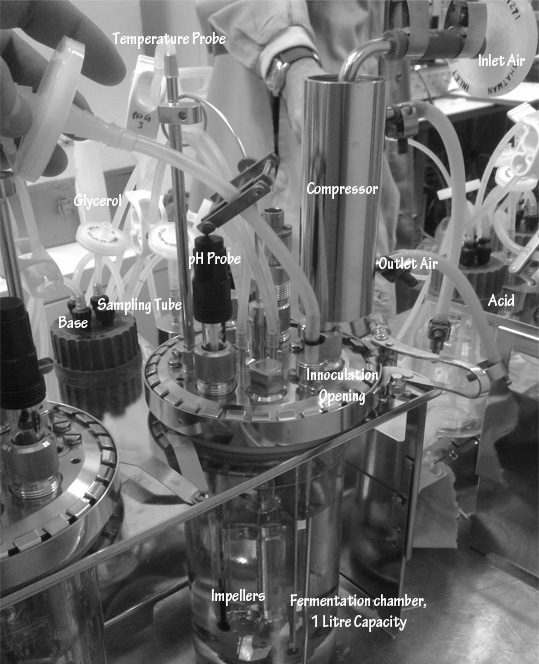Team:UCL London/Approach
From 2010.igem.org
| Line 1: | Line 1: | ||
{{:Team:UCL_London/templates/v2/headerFullWidth}} | {{:Team:UCL_London/templates/v2/headerFullWidth}} | ||
| - | + | ==BIOCHEMICAL ENGINEERING== | |
| - | + | ||
| - | == | + | |
| - | + | ||
| - | + | ||
| - | + | ||
| - | + | ||
| - | + | ||
| - | + | ||
| - | + | ||
| - | + | ||
| - | + | ||
| - | + | ||
| - | + | ||
| - | + | ||
| - | + | ||
| - | + | ||
| - | + | ||
| - | + | ||
[[Image:UCL-Fermenter-1-litre.jpg|450px|right]] | [[Image:UCL-Fermenter-1-litre.jpg|450px|right]] | ||
| Line 30: | Line 12: | ||
| + | ==Protein Expression== | ||
| + | ''E.coli'' is essentially one of the most widely applied in-vivo expression systems. The reason for its wide application is the fact that it is so well developed and the ''E. coli'' genome is fully developed and well understood. | ||
| + | In biotechnology, as an example, a DNA sequence for a protein of interest could be inserted into a high copy-number plasmid containing the lac promoter, which is then transformed into the bacterium Escherichia coli. Addition of IPTG (a lactose analog) activates the lac promoter and causes the bacteria to express the protein of interest. | ||
| + | One technique of insuring high levels of a protein is to clone the gene downstream of a well-characterized regulated promoter. In our case, we will be using pTAC, the tac promoter, a very widely used expression system. Being the strong hybrid promoter it is, it is repressed by the LacI protein, and on addition of IPTG, the lacI repressser is inactivated. This inactivtation breaks the strong repression of pTAC resulting in expression of pTAC. It has been shown that high expressions of pTAC is directly proportional to the concentration of IPTG added. And so by varying the concentratrion of IPTG added, you can regulate the rate of the expression of the desired protein downstream. | ||
| - | + | <html> | |
| - | + | ||
| - | + | ||
| - | + | ||
| - | + | ||
| - | + | ||
| - | + | ||
| + | <object width="920" height="700"><param name="movie" value="http://www.youtube.com/v/oFspmlm67AI?fs=1&hl=en_US&color1=0x234900&color2=0x4e9e00"></param><param name="allowFullScreen" value="true"></param><param name="allowscriptaccess" value="always"></param><embed src="http://www.youtube.com/v/oFspmlm67AI?fs=1&hl=en_US&color1=0x234900&color2=0x4e9e00" type="application/x-shockwave-flash" allowscriptaccess="always" allowfullscreen="true" width="920" height="700"></embed></object> | ||
| + | </html> | ||
Revision as of 23:53, 5 October 2010
BIOCHEMICAL ENGINEERING
That’s essentially the biology behind protein expression. The engineering side is where our project really gets interesting. In the biopharmaceutical industry, protein expression takes place on a large scale in devices known as fermenters. The recombinant E.coli cells are grown under a controlled environment within the fermenters whose scales can be as large as 10,000 L. A medium is firstly created containing vital chemicals which will ensure that the cells have the vital requirements to maintain growth.
Protein Expression
E.coli is essentially one of the most widely applied in-vivo expression systems. The reason for its wide application is the fact that it is so well developed and the E. coli genome is fully developed and well understood. In biotechnology, as an example, a DNA sequence for a protein of interest could be inserted into a high copy-number plasmid containing the lac promoter, which is then transformed into the bacterium Escherichia coli. Addition of IPTG (a lactose analog) activates the lac promoter and causes the bacteria to express the protein of interest.
One technique of insuring high levels of a protein is to clone the gene downstream of a well-characterized regulated promoter. In our case, we will be using pTAC, the tac promoter, a very widely used expression system. Being the strong hybrid promoter it is, it is repressed by the LacI protein, and on addition of IPTG, the lacI repressser is inactivated. This inactivtation breaks the strong repression of pTAC resulting in expression of pTAC. It has been shown that high expressions of pTAC is directly proportional to the concentration of IPTG added. And so by varying the concentratrion of IPTG added, you can regulate the rate of the expression of the desired protein downstream.


 "
"



 Twitter
Twitter Facebook
Facebook UCL
UCL Flickr
Flickr YouTube
YouTube